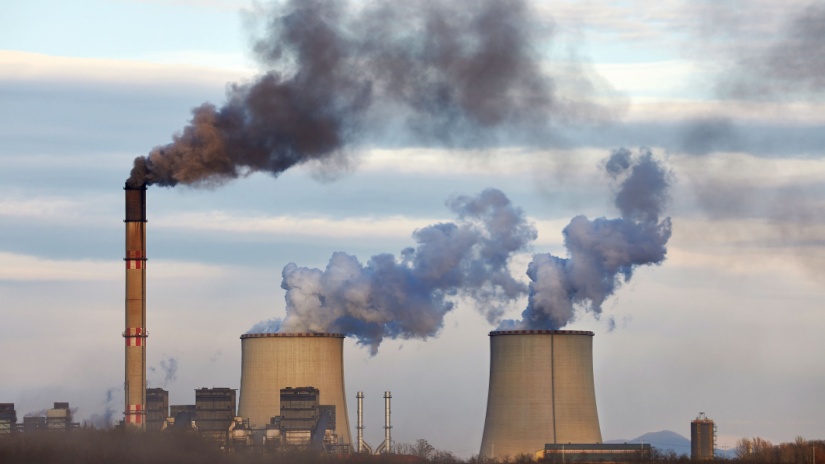Knowledge Centre
Understanding fossil fuels

In the current landscape of heated discussions on renewable energy, there's a growing focus on the extraction and applications of fossil fuels.
Despite their presence in our lives over the years, there remains a lingering ambiguity regarding their nature and contributions.
As the spotlight intensifies on renewable energy goals and the reduction of greenhouse gas emissions, navigating through the information can feel overwhelming.
What are fossil fuels?
Fossil fuels are energy sources made from the fossilised remains of plants and animals that lived millions of years ago. Over time, these organic materials were buried and underwent a process of fossilisation deep within the Earth's crust.
As they originate from organic matter, fossil fuels contain a high carbon content, which contributes significantly to their environmental impact compared to other types of energy sources.
Australia primarily relies on fossil fuels to generate energy. These fuels, including coal, natural gas, and oil, are predominantly combusted in large-scale power stations to generate electricity, which is subsequently distributed through the national grid.
In Australia, a significant portion of electricity production is derived from both black and brown coal burned in coal-fired power plants.
How do fossil fuels and renewable fuels differ?
The main difference between fossil fuels and renewable energy sources is how much pollution they create when we use them.
Fossil fuels, like coal and oil, release a lot of carbon into the air when they're burned. On the other hand, renewable sources such as solar, wind, and hydro power don't emit much carbon at all when they generate energy, which means they're better for the environment.
Another big difference is how quickly they replenish. Renewables can regenerate faster and more efficiently than fossil fuels, which take millions of years to form from decaying plants and animals. That's why there's a growing push towards using more renewable energy—it's not only better for the planet, but it's becoming easier and more reliable to harness.
In Australia, efforts to promote renewable energy include options like carbon-neutral energy plans, GreenPower programs, and incentives for installing solar panels and batteries. These initiatives are part of a broader shift towards cleaner and more sustainable energy choices.
Types of fossil fuels
There are three primary types of fossil fuels: coal, oil, and natural gas.
Coal
Coal is a solid fossil fuel rich in carbon, extracted through mining. There are two main methods for mining coal: underground mining involves machinery digging deep to extract coal from reservoirs, while surface mining removes layers of dirt and rock to reach coal deposits.
Coal plays a significant role in Australia's energy landscape, generating about 75% of the country's electricity and accounting for 40% of its primary energy consumption, according to Australian government data.
Oil
Also known as crude oil or petroleum, oil is a liquid fossil fuel typically found in underground reservoirs. Composed of hydrocarbons, oil is obtained through drilling on land or sea.
It is then transported via trains, trucks, or pipelines to refineries, where it is processed into various fuels like gasoline, propane, and kerosene.
Natural gas
Natural gas, referred to as LNG (liquefied natural gas) in Australia, is a colourless and odourless energy source predominantly made up of methane and other combustible hydrocarbon gases.
Like coal and oil, natural gas forms in underground reservoirs between layers of rock and sediment. It is extracted through drilling and transported through gas pipelines, commonly known as gas mains.
Fossil fuels: Advantages and disadvantages
Fossil fuels, like coal, oil, and natural gas, have both advantages and disadvantages:
Advantages
- Abundant, reliable. Fossil fuels are currently abundant and widely available in many parts of the world. They provide a reliable and consistent source of energy for various applications, including electricity generation, transportation, and industrial processes.
- High energy density. Fossil fuels have a high energy density, meaning they can provide a large amount of energy for a relatively small volume or mass. This makes them efficient for powering vehicles and generating electricity.
- Compatible with infrastructure. Existing infrastructure, such as power plants and transportation networks, is well-suited for fossil fuel use. This infrastructure supports the efficient extraction, processing, distribution, and use of fossil fuels.
- Money. Fossil fuel industries contribute significantly to national economies through job creation, tax revenues, and economic growth. They also support industries that rely on affordable energy, such as manufacturing and agriculture.
Disadvantages
- Environmental impact. Burning fossil fuels releases carbon dioxide (CO2) and other greenhouse gases into the atmosphere, contributing to climate change and global warming. They also emit pollutants such as sulphur dioxide (SO2), nitrogen oxides (NOx), and particulate matter, which can harm air quality and human health.
- Not renewable. Fossil fuels are finite resources that took millions of years to form. Once extracted and burned, they cannot be replaced within a human lifetime. Continued reliance on fossil fuels depletes finite reserves and raises concerns about future energy security.
- Pressure on resources. Extracting and processing fossil fuels can be resource-intensive and environmentally disruptive. Mining coal, drilling for oil, and fracking for natural gas can lead to habitat destruction, water pollution, and disruption of ecosystems.
- Volatility in prices. Fossil fuel prices can be volatile due to geopolitical factors, supply disruptions, and changes in global demand. This volatility can affect energy affordability and economic stability.
- Risk to public health. The combustion of fossil fuels and associated air pollutants contribute to respiratory illnesses, cardiovascular diseases, and other health problems, particularly in communities located near industrial facilities or major roadways.
What does the future of fossil fuels look like in Australia?
A new policy brief from the Griffith Asia Institute examines Australia’s 2024 green energy policies and their potential impact on Asia. Titled “A Future Made in Australia,” the report analyses how Australia’s ambitious green energy plans, including the “Future Made in Australia agenda,” could affect the Asia-Pacific region. Here are the key findings:
- Renewable energy growth. Australia aims to expand its renewable energy capacity, opening up investment opportunities in wind and solar power projects. This could lead to increased exports of renewable energy to Asia, strengthening economic ties with neighbouring countries.
- Hydrogen leadership. Australia’s initiatives in hydrogen energy could establish it as a global leader in hydrogen production. This is expected to benefit Asian nations seeking to diversify energy sources and reduce carbon emissions.
- Carbon neutrality targets. Australia plans to achieve carbon neutrality by 2050, setting an example for other countries in Asia. This proactive stance is likely to encourage regional cooperation on climate action.
- Sustainable development. The report emphasises Australia’s commitment to sustainable development through its green energy policies. By prioritising environmental conservation and responsible resource management, Australia aims to inspire similar practices in Asia, balancing economic growth with environmental stewardship.
How can we do better?
Australia is dealing with a growing climate crisis and higher living costs. The good news is we can tackle both issues together, like a two-for-one deal.
To lower energy bills and reduce emissions, we should make our homes more efficient and switch to renewable energy sources like wind and solar. By doing this, we can cut down on fossil fuels such as coal and gas, which are major contributors to climate change.
It's also important to use electricity more efficiently by improving how our homes and appliances consume energy. This approach will help Australia meet its emissions reduction goals and create a more sustainable future.
Advantages of renewable energy sources
If you’re looking to switch to renewable energy options such as solar or wind power for your home/business, take a look at the benefits of renewable energy sources:
- Renewable energy sources such as solar, wind, and hydroelectric power produce little to no greenhouse gas emissions or air pollutants, thereby reducing environmental impact and combating climate change.
- Unlike fossil fuels, which are finite and subject to geopolitical tensions, renewable energy sources are abundant and widely distributed globally, enhancing energy security and independence.
- The renewable energy sector creates more jobs per unit of energy generated compared to fossil fuels, offering opportunities for employment growth and economic development.
- Renewable energy costs have been decreasing steadily, and once infrastructure is established, operational costs are often predictable and stable compared to fluctuating fossil fuel prices.
- Using diverse renewable sources diversifies the energy mix, reducing reliance on a single energy source and enhancing resilience against supply disruptions.
- By reducing air and water pollution associated with fossil fuel combustion, renewable energy contributes to improved public health outcomes and lower healthcare costs.
- Renewable energy projects can bring economic benefits to local communities through investment, job creation, and revenue from land lease payments.
- Continued development and deployment of renewable energy technologies drive innovation, leading to advancements in energy storage, grid management, and efficiency.
- Renewable energy sources are sustainable, as they are naturally replenished and do not deplete finite resources, ensuring energy availability for future generations.
- Using renewable energy helps mitigate climate change impacts by reducing greenhouse gas emissions, which contributes to more stable and resilient ecosystems and communities.
Renewable energy vs fossil fuels: Cost of energy bills
When it comes to affording your energy bills, you might be considering which is better on the wallet. Renewable energy generally offers advantages for energy bills compared to fossil fuels, for several reasons:
Cheaper operating costs
Once renewable energy infrastructure is installed, operational costs tend to be lower or more predictable compared to fossil fuels, which are subject to price volatility influenced by factors like extraction costs and geopolitical events.
Natural power
Renewable energy sources like sunlight and wind are free and abundant, which means there are no ongoing fuel costs associated with generating electricity from these sources. In contrast, fossil fuels require continuous purchases and transportation of fuel, which can contribute significantly to energy bills.
Lower risks of price fluctuation
Renewable energy contracts often offer long-term price stability because they are not subject to fluctuations in fuel prices or carbon pricing mechanisms that may impact fossil fuel-generated electricity.
Energy independence
Using local renewable energy sources can enhance energy independence and reduce dependence on imported fossil fuels, which may be affected by global market volatility and geopolitical risks.
While the initial investment in renewable energy infrastructure can be higher, the long-term savings and stability in energy bills make renewable energy a favourable choice for many consumers and businesses aiming to manage energy costs effectively.
Talk to Compare Energy
If you’re currently looking to switch providers or look more into renewable energy options, we’ve got a team of experts on hand to help. Our Australia-based team can be reached on 1300 790 106.

